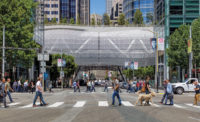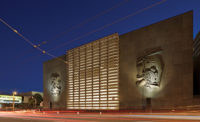In the 1960s, when the Northern California utility company Pacific Gas and Electric (PG&E) built a substation in the Tenderloin neighborhood of San Francisco, the company’s in-house design team went all-out on the exterior lighting. In addition to a row of modern sconces that provided dramatic uplighting, the building had a translucent backlit wall that dominated the corner of Larkin and Eddy streets. The sconces have been supplanted by security lighting, and the glowing wall has gone dark. However, the San Francisco–based firm TEF has brought some of the glimmer back with a small 12,000-square-foot addition to the main building.
Additional Content:
Jump to credits & specifications
On track to receive net zero certification, the facility’s new wing relies on natural ventilation to keep the equipment sufficiently cool, and on solar panels to power fans and high-efficiency LED lighting. The architects, who had previously worked on the PG&E Mission substation, presented several concepts, including a glazed wall that was inspired by the former light box around the corner. But, due to a 2013 attack on a San Jose substation during which the perpetrators shot at the electrical transformers and caused $15 million in damage, PG&E wanted an opaque facade. The design team then developed a solid wall with a dynamic pattern that conveys the idea of electricity moving through the city grid, both day and night.
“This building is part of the electrical grid, and we’re expressing that graphically,” says Paul Cooper, TEF principal. “It’s like a subtle billboard for PG&E.” Inspired by the map of the substation’s service area, the architects devised a rainscreen for the front of the building using 68 individually modeled glass-fiber-reinforced-polymer (GFRP) panels. The ridged panels, which were more cost-effective than concrete, generate a striped facade pattern that changes as the sun moves across the sky, gently offset by a lush, green wall that spans the elevation of an extended adjacent volume, housing a mechanical lift, on the right. Alternating panels protrude, resulting in drop shadows along the undulating surface and providing vertical and horizontal niches that accommodate lighting. To soften the building’s edges, the architects pulled the sculptural skin away from the structure, so that it floats over a layer of steel mesh that in turn overlays a galvanized-steel cladding. A section of panels along the facade’s left side and bottom row are punched by vertical slits, which provide an illusion of transparency.
At night, lighting accentuates the rippling architecture while addressing security requirements. “It was a careful balancing act,” says lighting designer Angela McDonald, who worked for Horton Lees Brogden Lighting Design at the time. “We wanted the effect to be compelling but not extravagant, and to establish a safe environment without being heavy-handed and using floodlights.” To activate the facade, McDonald and her team selected dimmable, color-changing LED strip lighting that is DMX512-compatible for flexible programming of potential color and animation applications. The system can be controlled in 6-inch segments to create an illusion of moving lights, and the dimming function can be used to produce a gentle, pulsating effect. On an evening in late September, the lights were set to a muted amber glow and vibrated softly across the building; the subdued effect was appropriately more “nightlight” than “disco.”
To highlight the multiple layers of the elevation’s left side, and accentuate its porousness, McDonald installed additional static-white 3,500K LED fixtures—warmer than typical street lights—behind the steel-mesh screen. She also edge-lit the bottom of the GFRP surface across the building to form a luminous horizon line above the building’s board-formed concrete base, a strategy that also fully illuminates the entrance and garage doors. The balance is both functional and aesthetic. According to McDonald, “You have a very utilitarian building, but you can still make it an engaging part of the neighborhood.”
CreditsArchitect: TEF Design, 1420 Sutter Street, San Francisco, California, 94109, 415.391.7918, https://tefarch.com/
Personnel in architect's firm who should receive special credit: Andrew Wolfram, AIA, LEED AP BD + C, Principal; Paul Cooper, AIA, LEED AP BD+C, Project Manager; Justin Blinn, AIA, LEED AP BD+C, Project Designer;
Interior designer: TEF Design, 1420 Sutter Street, San Francisco, California, 94109, 415.391.7918, https://tefarch.com/
Engineers: Structural: Rutherford + Chekene Civil: BKF Engineers MEP: MHC Engineers, Inc.
Consultants: Owners Representative: Jonathan Manzo, LEED AP, Urb-in Inc. Landscape Architect: Creo Landscape Architecture Lighting Designer: Horton Lees Brogden Lighting Design
General contractor: Plant Construction Company, LP
Photographer: Mikiko Kikuyama |
SpecificationsStructural System Foundation System: 3’ thick concrete mat slab designed to resist high ground water level Lateral System: Buckling-Restrained Braced Frames with moment resisting beam-column connections; designed under Risk Category IV with Importance factor of I=1.5 with anticipation facility will be operational after a major earthquake
Exterior Cladding Masonry: Basalite Concrete Products Rainscreen: Nvelope Moisture barrier: Vaproshield Fiber Reinforced Polymer (FRP) Panels: Kreysler & Associates Decorative Metal Screen: Cambridge Architectural
Roofing Built-up roofing: Johns Manville Traffic Coatings: Kemper System
Doors Metal doors: Stiles Custom Metal Fire-control doors, security grilles: Cornell Iron Special doors: The Smith Company
Hardware Locksets: Schlage Closers: LCN Exit devices: Von Duprin
Interior Finishes Paints and stains: Benjamin Moore Floor and wall tile: Crossville, Heath Ceramics
Lighting Interior ambient lighting: Lithonia, ALW Exterior: Ecosense, Luminii, iLight, Bega, Hydrel, Cree Lighting controls: Acuity Controls Exterior facade lighting controls: ETC
Conveyance Elevators/escalators: Pflow Industries
Mechanical Exhaust Fans - General Room: Greenheck Exhaust Fans - Restrooms: Panasonic
Plumbing Sump Pump: Weil Water Heater: Chronomite Water Closet: Kohler Urinal: Kohler Lavatory: Kohler Water Closet Flush Valve: Sloan Urinal Flush Valve: Sloan Lavatory Faucet: Kohler Roof Drain: Zurn Backflow Preventer: Watts
Energy Photovoltaic system: Sun Light & Power Landscape Wall: GSky |







Post a comment to this article
Report Abusive Comment